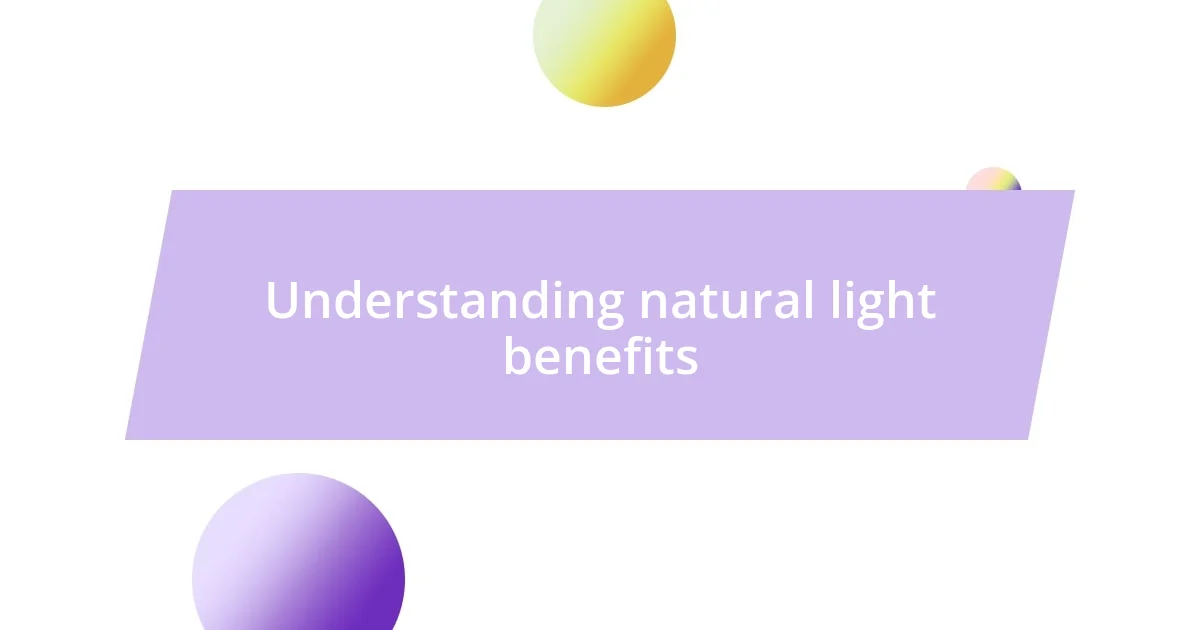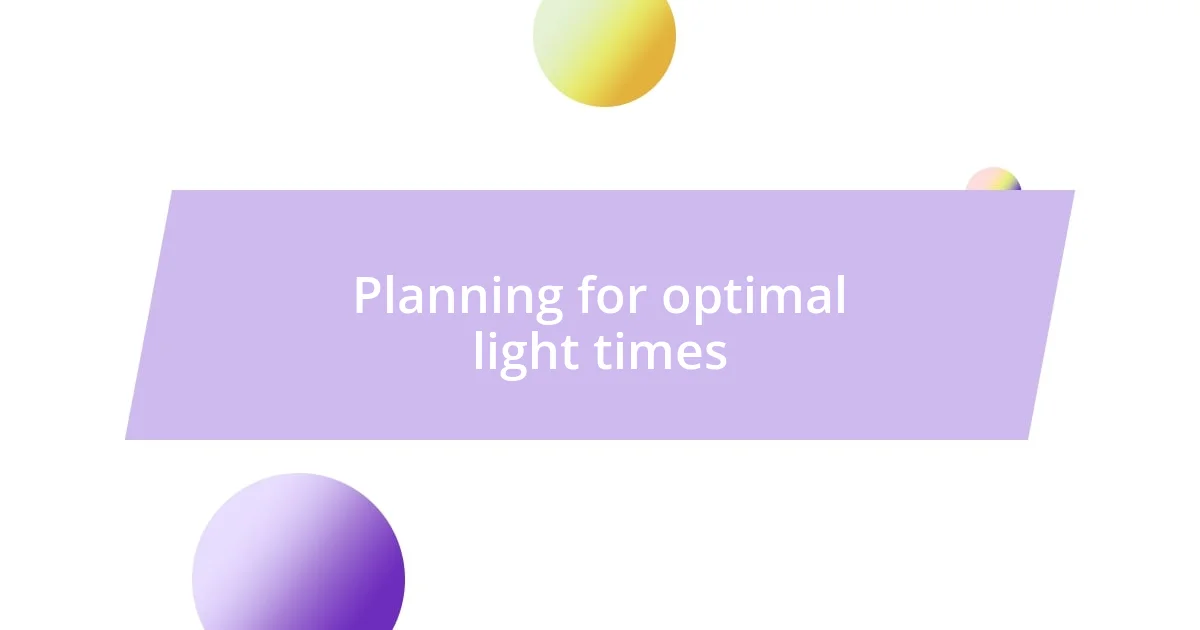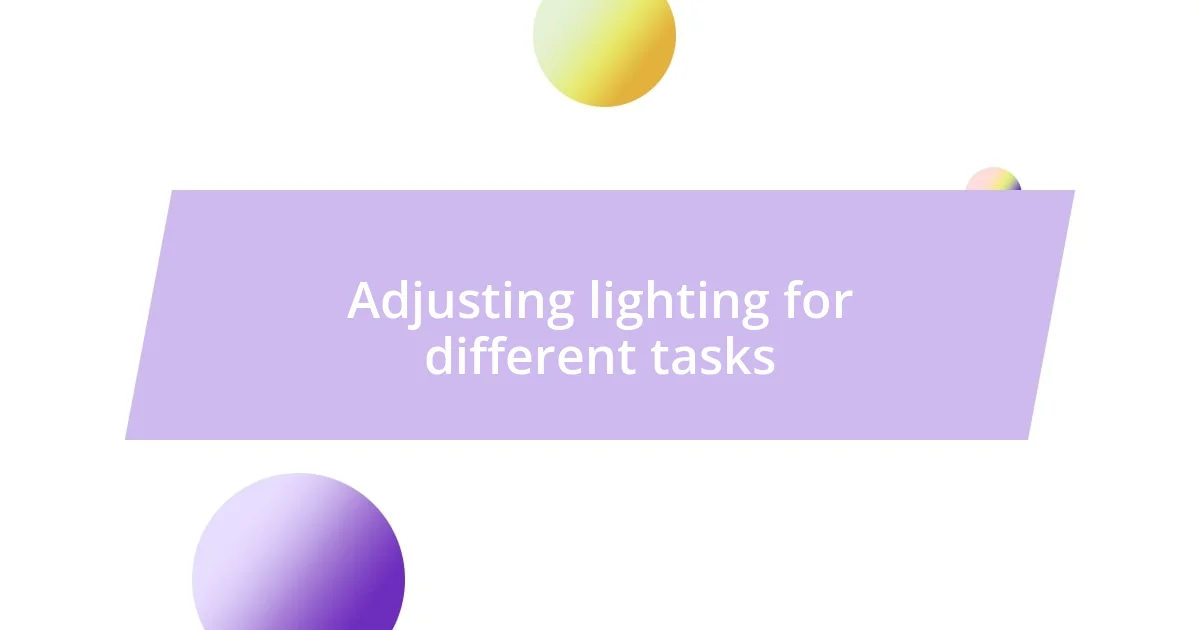Key takeaways:
- Natural light enhances mood, creativity, and overall well-being, influencing sleep quality and productivity.
- Understanding the time of day and type of natural light helps optimize spaces for comfort and efficiency, with morning light being energizing and evening light promoting relaxation.
- Adjusting furniture placement, color schemes, and light direction significantly impacts how light flows in a space, transforming the atmosphere and enhancing emotional well-being.

Understanding natural light benefits
Natural light transforms spaces in a way that artificial lighting simply can’t match. I remember once visiting a friend’s apartment that was flooded with sunlight in the morning; it was as if the room radiated warmth and positivity. Doesn’t a sunlit room feel more inviting? The benefits go beyond just aesthetics—they influence our mood, productivity, and overall well-being.
Think about the last time you worked near a window bathed in sunlight. For me, that little burst of daylight turned an ordinary task into an energized and enjoyable experience. Natural light has been shown to improve focus and creativity. When surrounded by it, I often find my thoughts flowing more freely. How often do you notice your energy levels spiking when the sunshine pours in?
Not only does natural light enhance our mood, but it also has long-term health advantages. Exposure to sunlight helps regulate our circadian rhythms, improving sleep quality. I’ve noticed that on the days when I intentionally seek out that sunlight, my sleep at night is deeper and more restorative. Isn’t it fascinating how a simple shift in our environment can profoundly affect our health and happiness?

Identifying the best light sources
Identifying the best light sources starts with understanding the different types of natural light available throughout the day. I’ve found mornings to be particularly magical; that gentle, golden sunlight spills in at just the right angle, creating a warm and inviting ambiance. On the other hand, the harsh midday sun can sometimes be overly bright, casting strong shadows that can detract from the comfort of a space.
In my experience, the source of light can greatly influence the mood of a room. I vividly recall a sunny afternoon spent working by my living room window. The sun filtered through the leaves of the nearby tree, creating lovely patterns on the floor. I realized then how important it is to consider not just the intensity of the light but also its quality and how it interacts with your surroundings.
When scouting for the best light sources, don’t overlook the significance of reflections. One time, I positioned a mirror opposite a window, and the transformation was amazing. That simple adjustment amplified the natural light significantly, making the space feel larger and brighter. It’s amazing how a few thoughtful adjustments can create a welcoming environment filled with daylight.
| Time of Day | Light Quality |
|---|---|
| Morning | Soft and warm, energizing |
| Midday | Bright and harsh, strong shadows |
| Afternoon | Golden hues, perfect for relaxation |
| Evening | Softening light, ideal for winding down |

Planning for optimal light times
Planning for optimal light times is all about being aware of how the sun moves and how that affects the quality of light in your space. I’ve learned that tracking the sun’s path can turn any room into a haven of natural light. For instance, I discovered that my kitchen becomes a cozy sun trap in the late morning. That little detail has me brewing coffee in that spot, soaking up the warmth, and enjoying every sip.
Here are some crucial factors to consider:
- Morning Light: An ideal time for energetic tasks. The light is soft and can boost your mood.
- Midday Light: Bright but sometimes too harsh; consider using sheer curtains to diffuse it.
- Afternoon Light: A golden hue appears, perfect for creative or relaxing activities.
- Evening Light: Softening light can create a calming environment, ideal for winding down after a long day.
Using a simple planner or even a note on your phone about when each room gets the best light can make a real difference. I remember jotting down these observations and actually looking forward to those sun-soaked afternoons; it felt like a little gift waiting for me each day.

Techniques for maximizing light flow
Maximizing light flow can be as simple as adjusting furniture placement. I once rearranged my desk to face a window, and the change was striking. Suddenly, instead of feeling confined in a dark corner, I was enveloped in a warm embrace of sunlight, which not only boosted my mood but also my productivity. Have you ever noticed how a fresh perspective on your space can surprisingly uplift it?
Another effective technique is to incorporate light colors into your decor. I’ve painted my walls in soft whites and pale yellows, allowing the natural light to bounce around like confetti. This subtle shift not only brightened up the room but created a soothing atmosphere where I felt more at ease. Isn’t it incredible how color can transform a space?
Lastly, using sheer window treatments is a game-changer. I remember switching from heavy drapes to light, airy curtains; it felt like I opened the floodgates to sunlight. The result was a beautifully diffused light that wasn’t blaring but instead gently illuminated the room. I’ve found that this balance between privacy and openness is essential for feeling comfortable in your home while still enjoying the benefits of natural light. What adjustments could you make in your own space to invite in more light?

Creating light-friendly layouts
Creating light-friendly layouts starts with embracing the flow of natural light throughout your space. I vividly recall relocating my seating area near the living room window one weekend. The transformation was remarkable! Suddenly, I was engulfed in a soft glow, making my reading time feel like a luxurious experience. Have you ever felt the difference a few feet can make?
Another crucial aspect is designing open layouts that encourage airflow and light to travel freely. In my own home, I opted for a less-cluttered approach by minimizing large furniture pieces in corners, which previously blocked light. Now, light filters into my space seamlessly, creating an airy environment that feels both welcoming and invigorating. It’s almost as if the room breathes and invites you in.
Finally, consider the height of your furniture. I once swapped out a bulky coffee table for a sleek, low-profile option, and the effect was immediate. It completely changed the room’s dynamics, allowing light to illuminate even the darkest corners. When was the last time you reevaluated your furniture’s height and placement? Even the smallest change can create a noticeably brighter, lighter feel in your home.

Using light to enhance mood
Using light has a profound impact on our emotional well-being. When I first experimented with morning sunlight flooding into my kitchen, I was amazed at how it lifted my spirits. There’s something about waking up to natural light that feels like a gentle nudge to begin the day with energy and optimism. Have you ever noticed how a sunlit room can chase away the remnants of sleepiness?
In my experience, the angle of light also plays a crucial role in shaping mood. I’ve observed how the soft evening glow, streaming through my living room window, creates a cozy and intimate setting perfect for unwinding. This soft illumination makes me feel relaxed and creates a serene atmosphere. The contrast between harsh artificial lighting and natural light is striking; how can something as simple as light direction influence our feelings so deeply?
I find that spending time in well-lit spaces during the day fuels my creativity. One afternoon, while basking in bright afternoon rays, I felt a surge of inspiration take over as I brainstormed ideas for a project. It’s interesting how our surroundings can either energize us or weigh us down, isn’t it? Optimizing natural light isn’t just about visibility; it’s about nurturing a vibrant emotional climate in our homes.

Adjusting lighting for different tasks
When it comes to adjusting lighting for specific tasks, I’ve realized that the intensity and direction of light can drastically affect my productivity. For instance, when I sit down to write, I prefer brimming sunlight pouring in from my left side. This positioning not only illuminates my workspace beautifully but also reduces glare on my screen, making it way easier to focus. Have you ever found yourself squinting while trying to read? Adjusting light direction can make all the difference.
During those late evenings when I tackle more detail-oriented activities like drawing or crafting, I’ve learned to soften the lighting. I dim the overhead fixtures and rely on a lamp with a warm, yellow glow. This creates a cozy atmosphere, allowing my creative juices to flow without overwhelming brightness. Can you remember a time when adjusting the light made you feel more in your element? I certainly can.
I’ve also found that some tasks benefit greatly from task-specific lighting. For example, when I’m prepping dinner, I love having bright, white light overhead. It helps me see the colors and textures of the ingredients vividly, preventing any cooking mishaps. It’s fascinating how something as simple as light can transform a mundane activity into a delightful experience. What lighting adjustments have you made in your own cooking space?














